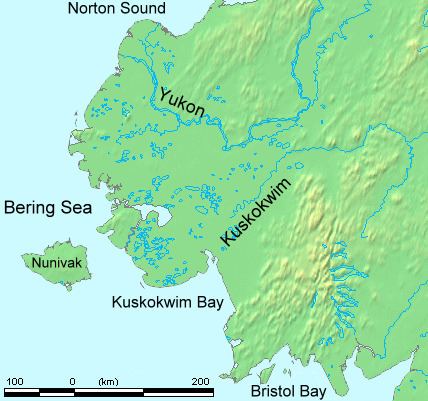Native to United States Writing system Latin | Ethnicity Cup'ig Linguist list esu-nun | |
 | ||
Region Central Alaska, Nunivak Island Language family Eskimo–Aleut
Eskimo
Yupik
Central Alaskan Yup'ik
Nunivak Cup'ig | ||
Nunivak Cup'ig or just Cup'ig (own name Cugtun) is a language or separate dialect of Central Alaskan Yup'ik spoken in Central Alaska at the Nunivak Island by Nunivak Cup'ig people (own name Cup'it or Nuniwarmiut). The letter "c" on the Yup’ik alphabet is equivalent on the English alphabet "ch".
Contents
The Central Alaskan Yupik who live on Nunivak Island (Nuniwar in Nunivak Cup'ig, Nunivaaq in Central Yup'ik) call themselves Cup'ig (plural Cup'it). Those who live in the village of Chevak call themselves Cup'ik (plural Cup'it). The name Cup'ig (with g) used for Nunivak Island Yup'ik dialect. But, the name Cup'ik (with k) used for Hooper Bay-Chevak Yup'ik dialect.
The Cup'ig dialect is threatened. This fact was documented by Dr. Michael E. Krauss of the Alaska Native Language Center at the University of Alaska and is illustrated on the map. At that time (1975) Krauss indicated, "Some of the children speak the language". Krauss documented continued decline and downgraded the status to "Very few or none of the children speak the language" in 1982.
Today Cup'ig is spoken by elders in the village of Mekoryuk.
Classification
The comparison of number names in the three dialects
Grammatical numbers
The grammatical numbers:
Education
The Cup'ig peoples' only school, the Nuniwarmiut School (P/K-12th grade), lays within the Lower Kuskokwim School District, in the village of Mekoryuk. Buiilt in 1984, the school provides English and Cup’ig bilingual education for 32 students.
Nuniwarmiut Piciryarata Tamaryalkuti, Inc. (literally, "Nunivak Cultural Programs") is a non-profit cultural heritage organization of the Cup'ig Eskimo village of Mekoryuk, its mission being to preserve Nunivak Island Cup'ig culture, traditions, and language. NPT was established in 1999.
Example phrases
Russian loanwords
The Russian loanwords used in Nunivak Cup’ig date from the period of the Russian America (1733–1867).
